- Char Dham (four abodes/seats) Yatra
The Char Dham covers four pilgrimage places – north, south, east and west – in India and was established by Adi Shankara.
- Badrinath
- Rameshwaram
- Puri
- Dwarka
The Char Dham is often considered the most revered sites to be visited by Hindus in their lifetime. It also established the four corners of the country.
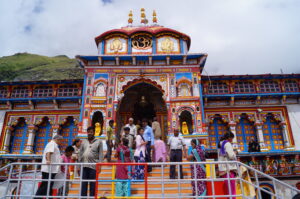
Badrinath is a holy town in the Garhwal Himalayas, on the banks of River Alakananda in the state of Uttarakhand. Badri refers to a berry that grew abundantly in the area (also a name for the Indian jujube tree), and Badrinath is “Lord of the badari tree”. It is sacred to Vishnu: “There in Badrikashrama the Supreme Being, in his incarnation as the sages Nara and Narayana, had been undergoing great penance since time immemorial for the welfare of all living beings” (Bhagavata Purāna 3.4.22). Badrinath was established as a major pilgrimage site by Adi Shankara. In the past, pilgrims used to walk hundreds of miles to visit Badrinath temple. In recent years its popularity has increased significantly, with an estimated 600,000 pilgrims visiting the dham. Badrinath is a one day’s journey from the main embarkation point. The temple and its surrounding village are accessible by road. The pilgrimage period is between June and September.
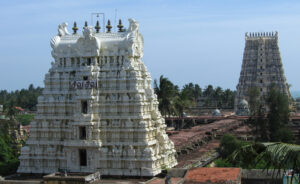
Rameshwaram is a sacred site for all Indians. It is said that Lord Rama worshipped Lord Shiva here after his victory over evil. This holy island is a place of pilgrimage and a symbol of cultural unity of our country. It is one of the 12 jyotirlinga sites. Several sacred water bodies are located around the temple. The pilgrimage at Rameswaram begins with a holy dip at the Agni Teertham followed by a bath at 22 other teerthams (wells) situated within the temple and concludes at Kodi teertham at Danushkodi.

Puri is the location of the temple of Lord Jagannath, dedicated to a form of Vishnu, and is located on the eastern coast at Puri, Odisha. The name Jagannath comes from the word Jagat nath, which means ‘Lord of the Universe’. The wooden forms of Jagannatha, Balabhadra and Subhadra – or Krishna, his brother Balaram and his sister Subhadra – are worshiped in this temple. Every twelve years these wooden figures are ceremoniously replaced by using sacred neem trees that have to be carved as an exact replica. The temple is an important pilgrimage destination, particularly for worshippers of Krishna and Vishnu, and part of the Char dham pilgrimages that a Hindu is expected to make in one’s lifetime. Nearly all the great Hindu acharyas have visited this kshetra, and Adi Shankara established his matha here.
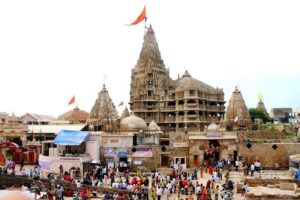
Dwarka is located in the western Indian state of Gujarat. The city derives its name from the word “dvar” meaning door or gate in Sanskrit. It is located where the Gomti River merges into the Gulf of Kutch. The legendry city ofDwarka is the ancient kingdom and home of Lord Krishna and was the first capital of Gujarat. It is one of the seven most ancient religious cities in India and the original Dwarkadish Temple was built around 200 BCE. However, due to damage and destruction by the sea, Dvaraka was submerged six times and modern Dwarka is the seventh city to be built in the area.
- Chota Char Dham
This is a shorter circuit restricted to Uttarakhand state.
- Yamunotri
- Gangotri
- Badrinath
- Kedarnath
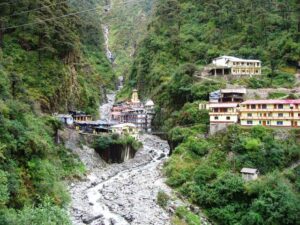
Yamunotri is the source of the River Yamuna and the seat of Goddess Yamuna, situated in the Garhwal Himalaya in Uttarakhand. The actual source is a frozen lake of ice called Champasar glacier located on the Kalind Mountain at a height of 4,421 m above sea level, about 1 km away. The image of Goddess Yamuna is made of black marble. The temple of Yamuna, a divine mother like Ganga, was constructed by Maharaja Pratap Shah of Tehri Garhwal. The temple opens every year on the auspicious day of Akshaya tritiya, which falls in the April-May, and closes on Dipavali day, in October-November, with a brief ceremony.
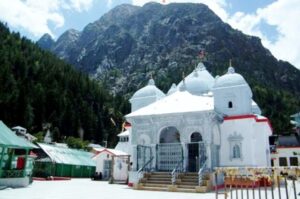
Gangotri is situated in Uttarkashi district of Uttarakhand state on the banks of River Bhagirathi, on the Greater Himalayas, at a height of 3,100m. It is the source of River Ganga (Ganges). The source of the holy river is Gaumukh in the Gangotri glacier, a 19 km trek from Gangotri. The river is called Bhagirathi at the source and becomes Ganga at Devprayag, where it meets the Alakanand. It is believed that Goddess Ganga took the form of a river to absolve the sins of King Bhagiratha’s ancestors, following his severe penance to liberate the souls of his ancestors and grant them salvation or moksha.
Badrinath – (see under Char dham, above)
Kedarnath
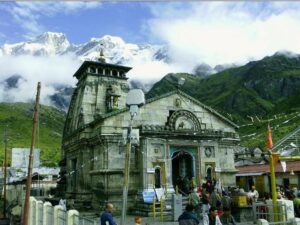
It is located in Rudraprayag district of Uttarakhand. The most remote of the Char Dham sites, Kedarnath is located in the Himalayas, about 3,583 m above sea level, near River Mandakini. Named after King Kedar, the temple existed during the Mahabharata period: the Pandavas did penance to Lord Shiva here. The temple opens on akshaya tritiya (April-May) and closes on bhai duj (October-November) due to heavy snowfall during winter. There are several places of pilgrimage near Kedarnath such as Rudraprayag, Gaurikund, Agastyamuni, Guptakashi, etc. Kedarnath suffered extensive destruction in June 2013 from flash floods caused by torrential rains.
- Amarnath Yatra
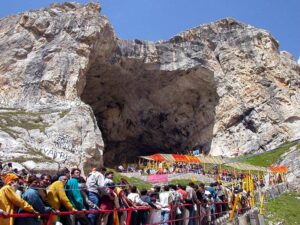
The Amarnath Cave, situated in Jammu and Kashmir is dedicated to Lord Shiva. Every year, inside the Amarnath cave, an ice Shiva Lingam forms, along with two other ice formations, representing Ganesha and Mother Parvati. The main Shiva lingam waxes and wanes with the phases of the moon, reaching its height in summer. The Amarnath yatra is held every year to pay homage to Lord Shiva and Mother Parvati. The temple is a very popular yatra destination for Hindus. Over 600,000 people visit it during the season. Devotees travel by foot from Srinagar or Pahalgam in a 5-day long journey.
- Kashi Yatra
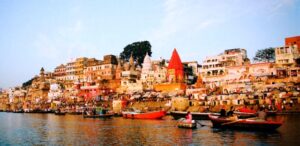
It is the greatest of all the yatras: a dip in the Ganges. Saikatha pooja is first done at Rameshwaram. The sand collected is immersed in the Holy Ganga at Triveni Sangamam at Allahabad where the Ganga, Yamuna and Saraswati meet. After Kashi Vishvanath darshan, Ganga water is collected to perform Ganga abhisheka to Lord Ramanathaswamy at Rameshwaram, which is a Jyothirlinga. Pilgrims also visit Gaya to perform Shraddha to their ancestors.
- Puri Rath Yatra
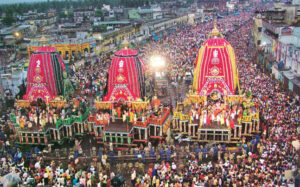
The Festival of the Chariot of Lord Jagannatha is held every year at Puri, Orissa. The 10 day rath yatra commemorates Lord Jagannath’s annual visit to Gundicha Mata’s temple, a short distance away. Thousands of pilgrims come to Puri during the festival with a desire to help pull the Lord’s chariot with ropes. This is the only day when devotees who are not allowed in the temple premises, such as non-Hindus and foreigners, can get a glimpse of the deities.
- Deoghar Yatra

Deoghar means abode of the Gods and Goddesses. It is also known as Baidyanath Dham or Baba Dham and is situated on the eastern side of Jharkhand. It is an important Hindu pilgrimage centre as Baidyanath Temple, one of the twelve Lord Shiva Jyothirlingams in India, is located here. The pilgrims carry the holy water of the Ganga from Sultanganj and offer it to the Jyotirlingam of Lord Shiva at Deoghar. These pilgrims, called Kanwariya, walk 109 KM to the shrine. The march of the Kanwariya takes place each year during the holy month of Shravan, the wet season. Shravani Mela is the most celebrated festival in Deoghar Baidyanath Temple of Jharkhand. It lasts for 30 days.
7. Pandharpur Yatra

The Palkhi festival of Maharashtra is one of the most popular festivals in India. The annual Pandharpur yatra to the famous Vithoba temple at Pandharpur is held every year during the month of June and July. Thousands of pilgrims come to Pandharpur carrying palanquins (palkhis) with the images of the saints of Maharashtra – Sant Dyaneswar from Alandi, Sant Tukaram from Dehu, Eknath from Paithan, and Nivruttinath from Trimbakeshwar. These pilgrims are referred to as Warkaris. They worship Vithoba, a form of Vishnu.
- Sabarimala
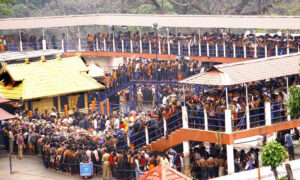
It is a Hindu pilgrimage centre located in the Western Ghat mountain ranges of Pathanamthitta District, Perunad grama panchayat in Kerala. It is the largest annual pilgrimage in the world. Sabarimala is believed to be the place where the Hindu God Ayyappan meditated after killing the powerful demoness Mahishi. Ayyappan’s temple is situated here amidst 18 hills. Sabarimala is linked to Hindu pilgrimage, predominantly for men of all ages. The temple is open for worship only during the days of Mandalapooja, Makaravilakku, Makara Sankranti and Vishu and the first six days of each Malayalam month.


